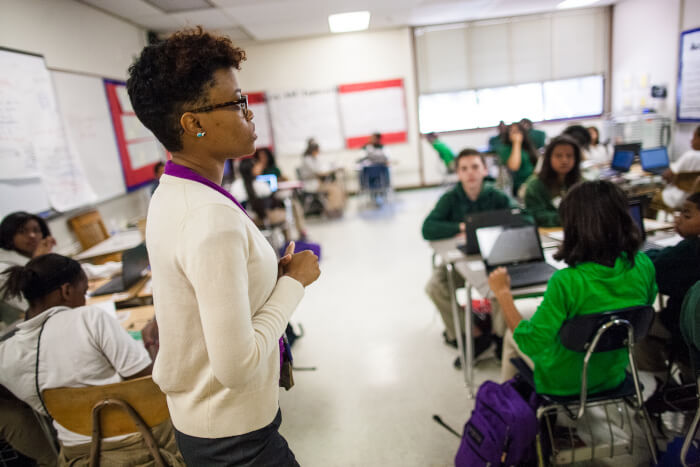Knowing how to begin class effectively is one of the most important skills a teacher can learn. How you start your class sets the tone for the lesson and the rest of the day. Icebreakers and warm-up activities are an excellent way to get students to open up so they’re ready to learn.
Teachers generally use two types of icebreakers: Ones at the beginning of the year that help students get to know each other, and daily warm-up activities. Consider using both in your classroom!

6 fun classroom icebreakers to start the year
As teachers, we always want to provide a welcoming learning environment where students are comfortable, able to participate and take risks. When the school year begins, many students enter the classroom with a bit of anxiety and apprehension. Using icebreakers at this critical time can help students get to know their peers in a casual, lighthearted setting while they adjust to you, your class, and your routines.
Here are a few fun icebreaker ideas to use in your classroom.
1. Getting-to-know-you bingo
Prepare a sheet of paper with bingo squares listing various facts about students in your class — eg., “Has two dogs,” “Has visited at least three states,” “Ate cereal for breakfast this morning,” etc. Give each student a sheet of paper, and have them find a student in the room who meets the criterion in the square. The student then writes their peer’s name in the appropriate square and moves on to find another partner. Students are not allowed to work with the same classmate more than once. Once someone has completed five squares in a row, they can shout, “Bingo!”
2. Scavenger hunt
Get students familiar with one another and their classroom with a scavenger hunt. Students follow clues about classroom procedures to find other clues and objects hidden around the room. Teachers can create instructions such as, “Find the place where you turn in your papers. What color is the envelope sitting in this spot today? Write the color of the envelope on your scavenger hunt notes.” Once a team has completed the scavenger hunt, they will have walked through the classroom procedures and answered some questions along the way.
3. Six-word story
Students write a story about their summer vacation in just six words and share it with the rest of the class. This is trickier than it sounds! Classmates can then respond to a student’s story, but again in just six words. This is a fun challenge for the entire class that also helps students get to know each other a little better, all while encouraging creativity.
4. Snowball fight
Students write two facts about themselves on a piece of paper, then wad up the paper like a snowball and toss it into the middle of the room. Each paper is then opened and read aloud to the class. Students can try to guess who wrote the “snowball,” or the writer can reveal his or her identity. The student can then elaborate on what they wrote, and classmates can ask questions.
5. The marshmallow challenge
This is an active team challenge where students are put in groups and given 20 sticks of raw spaghetti, a marshmallow, some tape, and some yarn. Their goal is to work as a team and use these materials to build the tallest structure. Students get to know each other as they work together to solve this fun challenge.
6. Question web
The teacher begins with a ball of yarn and asks a question such as, “If you could eat dinner with anyone in the world, who would it be and why?” You then pinch a length of yarn in one hand and toss the rest of the ball to a student. The student answers the question, holds onto a short length of the yarn, and tosses the ball to yet another student. Rinse and repeat! Once everyone has answered, the teacher can draw attention to the web of yarn in front of the students to illustrate how the class is connected and woven together.

5 daily icebreakers for your students
Once students know each other fairly well and you’ve established classroom expectations, you can continue using icebreakers to kick-start lessons. These attention-grabbing warm-ups can help students review, practice and preview material.
Daily icebreakers help establish a pattern of expectations in the classroom. They’re a great way to help with classroom management because students enter the classroom and know to get started immediately on the warm-up for the day. Here are some easy activities to add to your routine. (For more, check out these eight creative classroom management ideas.)
1. Question of the day
Students are greeted each day with a new question on the board and are expected to start writing an answer. This can be a general question about their weekend or something about a current class topic. For a science class learning about the solar system, for example, you might ask, “Do you think we’ll be able to live on other planets someday? Why or why not?” Students can then turn to a partner and share their thoughts. Afterward, the teacher can then host a quick class discussion to connect the students’ thoughts to the day’s learning objectives.
2. Listen to a song
In a language arts class, have students pick up a copy of song lyrics as they enter. When class begins, start the song. Students can circle certain parts of speech in the lyrics (adjectives, pronouns, etc.) as they listen. With older students, you could do this for history class and have them analyze the meaning of a song in a particular historical context. At the end of the song, students can group up in pairs to discuss what they think the song is about. The teacher can then wrap up the icebreaker by relating the music to the lesson for the day.
3. Project an image
Teachers can project a photo or comic for students to discuss as a class. History teachers can find an old photo and get students thinking about the lesson. You can also ask students to identify how certain things in the photo differ from the way they are today. As an extra challenge, ask students to guess which year or decade the photo was taken. These images can help students contextualize the information you teach. For visual learners, this activity is an effective way to make certain facts more memorable.
4. Play a game
Energize students as soon as they walk into class by driving straight into an interactive game. Review what was taught during the week with Jeopardy. Use Pictionary to review vocabulary. You can also use technology by having students compete against one another or work collaboratively through educational games. This is a great way to see how much students remember and identify areas for review before an upcoming exam.
5. Show a quick video clip
Start class with an inspiring, informative, or interesting video! Use a short National Geographic or Nature documentary clip or a YouTube video from Crash Course. This is an excellent way to grab students’ attention and get them thinking about what they’ll be learning today.
Starting with something fun gets students ready!
Beginning your school year (and day) with icebreakers can make a huge difference in your classroom. Students will enjoy interacting with their peers and getting to know each other more as time goes by. More importantly, starting class every day with an interesting activity will get students excited about learning and help prepare them for success.
Photo credit: Google
Classroom Management


